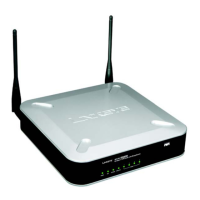14
Chapter 6: Configuring the Wireless-G VPN Router
Overview
Wireless-G VPN Router with RangeBooster
• Wireless Network Access. This screen displays your network access list.
• Advanced Wireless Settings. For advanced users, you can alter data transmission settings on this screen.
• WDS. This tab is used for Wireless Distribution System (WDS).
Firewall
• General. On this screen, you can configure a variety of filters to enhance the security of your network.
• Port Forwarding. To set up public services or other specialized Internet applications on your network, click
this tab.
• Port Triggering. To set up triggered ranges and forwarded ranges for Internet applications, click this tab.
• DMZ. Click this tab to allow one local user to be exposed to the Internet for use of special-purpose services.
• Access Restriction. This tab allows you to block or allow specific kinds of Internet usage and traffic during
specific days and times.
• URL Filtering. This tab allows you to create an URL Filtering policy.
VPN
• VPN Client Access. Use this screen to designate VPN clients and their passwords.
• VPN Passthrough. This tab is used to allow VPN tunnels to pass through the Router’s firewall using IPSec,
L2TP, or PPTP protocols.
• IPSec VPN. The VPN Router creates a tunnel or secure channel between two endpoints, so that the
transmitted data or information between these endpoints is secure.
• VPN Summary. This page summarizes the comprehensive details of IPSec VPN Tunnels.
QoS
• Application-based QoS. This involves Internet traffic, which may involve demanding, real-time applications,
such as videoconferencing.
• Port-based QoS. This ensures better service to a specific LAN port.

